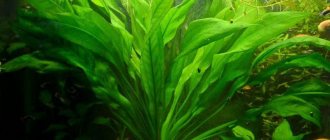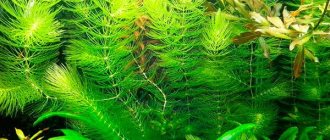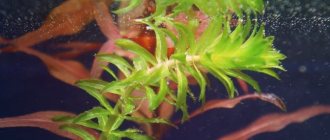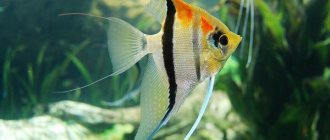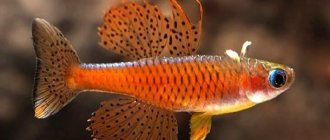author: fisher 12/02/2018 0 Comments
Aquarium plants
Bucephalandra
Having appeared in hobby aquariums only in the 21st century, Bucephalandra continues to gain popularity. This is facilitated not only by the variety of shapes and colors of leaves, but also by the relative unpretentiousness of these plants.
Despite the fact that the peak of popularity of Bucephalandra among aquarists has occurred in recent years, these plants have been known to science for quite a long time.
The first Bucephalandra was described by the Austrian botanist Heinrich Schott back in 1858. It was named Bucephalandra motleyana. And it is a small plant up to 20 cm high. The shape and color of the leaves varies widely: from lanceolate green to elliptical red-brown.
Over the next almost 150 years, Bucephalandra were practically unknown to aquarists, and their scientific taxonomy remains in its infancy to this day.
The next species was described only at the end of the twentieth century, in 1984, by one of the most famous, modern specialists in aroids, Joseph Bogner, and was named B. gigantea, due to its impressive size. Although in modern aquarium farming, bushes 40 cm high can hardly be called gigantic.
In 2001, a small batch of Bucephalandra , under the common name Bucephalandra Motley, was brought to Holland, where it created a sensation among aquatic plant lovers.
For a long time it was believed that all representatives of the genus less than 20 cm in size, regardless of leaf shape, are varieties of Bucephalandra Motley.
Bucephalandra sp. Velvet leaf
Bucephalandra is not widespread in Europe They could only be seen in scientific institutions and public aquariums.
Until 2012, only three species of these plants were mentioned in the official botanical literature - Bucephalandra gigantea, B.magnifolia and B.motleyana, with all other varieties of Bucephalandra being classified as a single species - B.motleyana.
The breakthrough came in 2021, when another 25 new species of these plants were described in a short period. And all this thanks to the first taxonomic revision in a century and a half, carried out by Malaysian botanist Peter Boyce and his wife Sin Wong.
By the end of 2021, the number of species with a biological description exceeded 30. The main taxonomic characteristics in the revision carried out by Boyce were the structural features of miniature inflorescences of Bucephalandra .
An interesting fact is that the plants also owe their name to the structure of the inflorescence. The word Bucephalandra comes from three Greek words: “bous” - bull, “kephale” - head and “andros” - male, due to the external resemblance of the stamens to the head of a bull.
According to hydrobotanists, in the near future the genus Bucephalandra may increase to fifty species.
Bucephalandras to Russia in 2009, and already in 2010, aquarium plant lovers were able to evaluate new products at Russian aquarium design competitions. Their beauty was amazing, and the ability to bloom underwater made Bucephalandra a sensation of the year.
A great contribution to the popularization of Bucephalandra in Russia was made by domestic aquarists - Dmitry Loginov, Konstantin Pakhomov, Mikhail Borodin and Sergey Bodyagin.
The new descriptions have not yet found practical application among aquarists, since it has turned out to be very difficult to use the main keys to determine the species at home.
Many species that have not yet been described have the abbreviations sp in their names. or cf., which means there is no scientific name.
In the aquarium hobby, such plants receive trade names that are invented by aquaflora suppliers, often by the name of the area where they were found, or by the color of the leaves.
The appearance and biological features of Bucephalandra have much in common with Anubias and Cryptocorynes, therefore in the aquarium hobby these plants occupy an intermediate position between them. The leaves of Bucephalandra are similar in shape and color to Cryptocorynes, and the creeping rhizome with rhizoid roots capable of clinging to the substrate is very similar to those of Anubias.
Creeping rhizome with rhizoid roots allows Bucephalandra to attach to various substrates
Like Anubias, Bucephalandras easily move from an aquatic environment to an airy one and vice versa, while they do not shed their leaves, and their underwater and above-water leaves are practically the same in appearance. Underwater leaves are slightly brighter and thinner than above-water leaves.
Bucephalandra easily adapts to different lighting conditions. In low light, their growth slows down, the leaves enlarge and become lighter.
In bright light, the growth rate increases to 1 leaf per week, and the leaves become denser and narrower, acquiring, depending on the species, different colors from dark green to burgundy, often with clearly visible dotted spots. A thin layer of a kind of waxy varnish forms on the surface of the leaves, giving the bucephalandras even more decorative.
Bucephalandra with cryptocorynes : when submerged, they are susceptible to cryptocoryne disease, when, with a sharp change in growing conditions, the plant immediately sheds all its leaves.
But unlike the latter, the plant does not die, thanks to the supply of nutrients in the rather thick rhizome. After adaptation to new conditions, the leaves grow back.
All Bucephalandra are endemic to the island of Kalimantan, which is located in the equatorial zone and is of volcanic origin. The size of the island is only slightly short of 1 million square meters. km., so the climate in different parts of it may differ markedly.
The only climate indicator that remains constant is air temperature.
The island is dominated by hilly terrain. The hills generally have a height of no more than 1000 meters above sea level and start from the coast itself.
In the lowlands and foothills, air temperatures usually range from 28 to 30°C, and only at the top of the island’s highest mountain, Kinabalu (4095 m), can it drop to zero.
At high temperatures, intense evaporation of water occurs, followed by its condensation in high mountain areas or tree crowns at night. All this creates high humidity.
Precipitation is seasonal with a distinct rainy season occurring from November to February.
Bucephalandra sp. Cherish
Almost every hill has its source in a small stream or river, which is fed by water that falls in the form of precipitation or formed due to the condensation of moist air, due to which the water in them has very low hardness (about 1dGH) and an acidity pH of about six units.
Running down the slope, in the path of such watercourses there are often areas with sharp changes in elevation, where waterfalls form. Falling masses of water are effectively saturated with carbon dioxide and oxygen, creating the humidity necessary for the development of rheophytic plants. It is in the vicinity of waterfalls, in well-lit areas with fast flows, that Bucephalandras .
Bucephalandra in natural conditions decreases in direct proportion to the distance from the waterfall. In flat areas of the stream bed, these plants are much less common.
Throughout the year, the water temperature in the reservoirs of Kalimantan never drops below 20°C. The wet season can last up to six months. It is during this period that thickets of low-growing bucephalandra go under water, where they remain for 6 to 8 months, the rest of the time they spend in the air.
The beds of mountain rivers and streams are mainly covered with silicate rocks, in particular basalt and quartz, which are neutral in nature and have virtually no effect on the composition of the water. However, there is an assumption that the speciation of Bucephalandra occurs to a large extent under the influence of the substrate species, coupled with the surrounding microclimate. This assumption is based on the fact that in each individual stream only one species of Bucephalandra , which makes these plants very vulnerable.
The rocky coastline of natural biotopes determined the ability of Bucephalandra to attach to various substrates.
Thanks to this ability, in an aquarium, bucephalandra can easily be used to decorate driftwood, stones and ceramic decorations.
With the help of their tenacious root system, plants not only attach to rocky shores and boulders protruding from the water, but also retain nutrient dendrite particles carried away by the water flow.
Based on the nature of the biotopes, we can conclude that Bucephalandra are typical rheophytes (growing in fast flows of water).
Moreover, the water level in streams, depending on precipitation and time of day, is constantly changing. These differences can reach a meter in height, sometimes flooding the plants, sometimes again exposing the rocky shores with clumps attached to them.
Under natural conditions, the neighbors of Bucephalandra , most often, are their distant relatives - Piptospatha and Ooia.
An interesting fact is that, regardless of the presence of waterfalls, Bucephalandra does not grow in streams flowing near the sea coast. Perhaps this is prevented by strong winds blowing from the sea and preventing the accumulation of moisture in the air.
Plants that require less moisture, such as piptospata and aridarum, grow in such watercourses.
Bucephalandras are found exclusively in the central regions of the island.
Why does everyone need bucephalandras?
A little over ten years ago, most Russian aquarists did not even suspect such a miracle of nature as Bucephalandra. The plant changed their ideas about underwater flora in 2010. Then he was presented at several exhibitions at once. And, of course, it left no one indifferent.
Not only did the exotic look great on its own: the leaves of various shades with a scattering of small spots attracted the eye. But the main feature of Bucephalandra is that it blooms. Moreover, for this, it does not need to produce flower stalks above the surface of the water, like other aquatic plants. Buds appear in its thickness.
Bucephalandra flowers are truly beautiful and even exquisite. They resemble calla lilies. This is the same cob, wrapped in a blanket. Most often white, although there are other variations, from cream to bright yellow.
It is not surprising that when Russian lovers saw the bouquet peacefully swaying in the water, they could not pass by such a miracle. Rather, something else is surprising: why did they know nothing about the underwater flower for so long? After all, scientists described them much earlier.
The first Europeans to describe Bucephalandra were the Austrian Heinrich Wilhelm Schott and the Englishman James Motley. They discovered the underwater flower back in 1858. The tragic death of Motley prevented a comprehensive study of the plant. Its discovery was forgotten for 150 years.
In the early 2000s, Bucephalandra was finally brought to Europe. However, it did not cause a stir. Only Dutch and Japanese breeders showed interest in the discovery.
In Russia, several people are seriously studying the plant. First of all, these are Sergei Loginov, Mikhail Borodin and Konstantin Pakhomov. They willingly share observations made during expeditions on their blogs.
Borneo Island. How Bucephalanders live in their homeland
Bucephalandra is 100% endemic. That is, plants that grow locally in only one place on Earth. Their home is the island of Borneo, the largest in the Indonesian archipelago.
Despite the similar climate and geographic proximity, underwater flowers have never colonized the other islands of the archipelago. During the expeditions, no bucephalandra were found on any of them.
The climate on the islands has its own characteristics. It rains non-stop for about six months, filling the rivers to the maximum. At this time, the bucephalandra are completely under water. And when tropical rains are replaced by heat and water bodies become shallow, they quickly adapt to living in the air.
It is interesting that, unlike other types of similar plants, their leaves hardly change color, shape, or size. The ability to maintain “your face” will tell experienced aquarists a lot. At a minimum, it means that the underwater flower has a fair degree of adaptability to existing conditions. And this greatly simplifies the task of growing them in your aquarium, florarium or paludarium.
And, of course, any child knows that Borneo is always hot. The water temperature on the island does not drop below 20 degrees. Accordingly, the heroine of this article is very thermophilic.
Epilogue
Despite the fact that most of the island is a conservation area designated as national parks. In unprotected areas, biological resources are being developed at a rapid pace, with the ensuing consequences. Thus, cutting down tropical forests for agricultural land and building roads causes irreparable damage to natural biotopes.
Plant collectors cause serious damage to natural Bucephalandra Increased interest in Bucephalandra has greatly increased the demand for these plants both in Europe and other countries of the world, which encourages the local population to make money by collecting plants.
The slow growth rate of Bucephalandra does not allow them to recover quickly. And the peculiarities of their growth on stones lead to the fact that after collecting the plants, in the place where they grow, there are not even fragments of roots left from which the colony could be restored.
In the current situation, Bucephalandra can only be saved by mastering the methods of their reproduction in aquariums, thereby reducing the import of these plants from nature.
The huge variety of shapes and colors of these plants make it possible to create a piece of the virgin tropical forest of distant Kalimantan within the framework of a home paludarium.
Rules of content: the main thing is stability
Growing Bucephalandra is not a difficult task. The plant is quite tolerant of different conditions. When arranging a corner for it, you can focus on the indicators given in this table.
| optimal performance | acceptable indicators | |
| temperature | 22-28° C | 20-32° C |
| rigidity | any | any |
| acidity | 5.6-7.4 pH | 5.0-8.0 pH |
| lighting | Moderate | From strong to shadow |
Experiment. Aquabotanist Mikhail Borodin tested the resistance of Bucephalandra experimentally. He placed the plants in purified water with a pH level of 5.0 - 5.5 and almost zero hardness. At the same time, the plant not only survived, but also bloomed beautifully.
Observations of the plant have shown that the most important component of its successful development is consistency. It is ready to stoically endure any test with one condition: no sudden changes in hardness, acidity, temperature or lighting.
In case of decisive changes, Bucephalandra may shed its leaves. In aquabotany, this effect is called “cryptocoryne disease.” True, cryptocorynes, which gave the name to this phenomenon, are doomed to death after such a procedure. Their underwater blooming “followers” are likely to survive.
The nutrients accumulated in the rhizome should be enough for the entire recovery period after stress. So in this case, the growth of new leaves is only a matter of time.
Bucephalandra also responds well to:
- CO2 feeding;
- fertilization with iron-containing preparations;
- weekly change of a small part of the water.
Features of growing Bucephalandra
Bucephalandra has some features that make it even more interesting for aquabotanists.
- Tenacious rhizomes. Thanks to them, Bucephalandra is able to live on any soil and securely attach to snags, stones and other decorative elements. Nutritional value is absolutely not important.
- Easy change of water/air modes. A plant can feel equally good in both elements and at the same time not lose its ability to bloom.
- Ability to control leaf growth and color. This is done by adjusting the lighting. If it is weak, new leaves will appear one per month or even a little less often. They will be light and large. Bright light will allow you to “throw away” a sheet per week. At the same time, they will become narrower and more graceful and can acquire an interesting color, from coffee brown to noble dark blue.
Bucephalandra motleyana "Riam Macam"
Found in Kalimantan, the Indonesian part of Borneo. A very beautiful species, the color of the stems resembles a red-brown form, but has a bright green leaf blade. The leaves are raised up. Forms compact, squat bushes that remain truly small in size.
Bucephalandra motleyana "Gunung Sumpit"
Keeping in an aquarium
Plant rosettes are usually placed in the foreground or middle ground. It is enough to tie the plant to a pebble or driftwood, and pretty soon it will send out roots and entangle its support with them.
- Perhaps the only difficulty that may arise when growing a flower in water is that it is susceptible to algae fouling. Reducing daylight hours to 7-8 hours will help prevent this.
- A weak solution of citric acid will help get rid of algae. It is enough to soak the infected plant in it for 30-40 minutes. Bucephalandra itself is hardy enough to withstand such a test. Polish flower admirers boldly use this method and recommend it to their Russian colleagues.
Growing on a windowsill
If desired, Bucephalandra can be grown using the “dry” method. Aquarist Sergei Bodyagin succeeded in this. His plants not only grow and bloom successfully, but also produce viable seeds.
Plants with a developed root system are ready for life in the air. Bodyagin keeps them in a nutrient solution, which he changes periodically. A special moisture-retaining soil has also proven itself well.
Bucephalandras feel good in florariums. They make it much easier to maintain the high level of air humidity needed by plants.
It should be understood that the leaves produced by a flower growing in air will be different from those that appeared in an aquatic environment. Most likely, they will not be as colorful and elastic. However, the decorative qualities will still be quite high. And the flowers will delight you with sophistication and tenderness.
Rot should be feared. It easily appears and reproduces in a humid microclimate. Treatment with special preparations will help prevent its development.
Reproduction of Bucephalandra
The most accessible and simplest method of propagation is vegetative. When new shoots form independently when the mother plant reaches a certain size and age. But to obtain a sufficient number of plants in aquarium conditions when propagating using this method, it takes a lot of time.
Bucephalandra be propagated similarly to Anubias, by dividing the creeping rhizome. It is not advisable to immediately fix a separated part of the rhizome with roots, 1-2 growing points and several leaves on a stone or driftwood; it is better to first plant it in the ground to develop a branched root system, and only then attach it to the substrate.
The process of obtaining new plants can be accelerated by growing them in greenhouse conditions, but in this case other problems arise associated with a whole range of infectious diseases that usually infect natural specimens.
Reproduction by tissue culture cloning (meristem) is practically impossible at home.
The most promising method seems to be generative (seed) propagation, since it does not have the disadvantages of the above methods.
The pollination process of these endemics of Kalimantan is somewhat more complicated than that of Anubias and its methodology has not yet been fully developed.
Both groups of plants are characterized by an inflorescence in the form of a spadix with unisexual flowers divided into zones with different periods of their maturation. For successful pollination, it is necessary to collect pollen from one inflorescence in a timely manner, and then, using a brush, after removing the cover, apply it to mature female flowers.
The development cycle of Bucephalandra is shorter compared to Anubias.
As a result of a single successful pollination, in a year and a half, you can get more than one hundred adult specimens. The fruit of Bucephalandra ripens in 1.5-2 months (which is twice as fast as that of Anubias) and on average contains about five hundred seeds.
Germinating seeds is easy and does not require large containers. In principle, you can limit yourself to standard plastic containers for growing seedlings. To obtain seedlings, you can do a thickened planting, after which at a certain stage the plants are planted.
The plants obtained in this way are completely free from infectious diseases and their further cultivation in greenhouse conditions is not difficult.
The advantages of artificial seed propagation of Bucephalandra are obvious.
In the future, the seed propagation method will not only significantly reduce the import of Bucephalandra from their natural habitats, but also improve the health of their culture.
Bucephalandra in the paludarium
Growing plants in a paludarium has its own nuances and difficulties. But aquarist Konstantin Pakhomov took up this business with enthusiasm, becoming one of the pioneers. Through trial and error, he developed a set of rules.
- He advises paying close attention to the paludarium model. It is important that the lamp is positioned high enough, otherwise it can burn tender leaves that lack water protection.
- It is also desirable that ventilation be present. Although it does not provide a 100% guarantee against mold formation. The aquarist managed to cope with it only with the help of daily ventilation.
- Pakhomov advises planting new plants on a surface lined with moss. This frees you from the obligation to control and maintain a high level of humidity: the moss will cope on its own and will not allow the roots to dry out.
Method one. Fastening with thread
One of the simplest methods of fastening, involving the use of ordinary thread. First, take scissors and cut the moss into small pieces, then lay them on a piece of driftwood or stone and wrap them with thread. After about 2-3 weeks, the thread will decompose in water, but during this period the moss will have time to attach itself with rhizoids .
This method has 2 serious drawbacks:
- moss does not always grow to the surface before the thread decomposes;
- on small snags (especially branchy areas) it is sometimes quite difficult to secure the moss with a thread.
ADA Moss Cotton
Please note ! Some manufacturers produce special cotton thread - for example, ADA Moss Cotton. It is not very noticeable in the aquarium, because it has a greenish tint. Completely decomposes in an average of 2-4 weeks. Although even special threads do not reduce all the disadvantages of this fastening method.
*We do not recommend this mounting method.
How to make Bucephalandra bloom?
Undoubtedly, the main reason why people get Bucephalandra is its unusual flowers. As a rule, the plant does not skimp on them, and even beginners manage to see them sooner or later.
Bucephalandra is translated as "bull". It received this name because of the pistil of the flower, which resembles the head of this powerful animal.
Aquabotanists have not yet come to a common conclusion regarding the mechanisms of flowering. Some believe that it is a response to disastrous conditions. Others defend the exact opposite point of view, declaring that Bucephalandra blooms only where it feels good.
Bucephalandra is still new to Russian aquariums, florariums or paludariums. However, the newcomer is promising, who is gaining more and more fans every year. Aquabotanists predict great fame for the underwater flower. All the ingredients for success are there: exotic beauty and undemandingness.
Spreading
This plant grows in Southeast Asia. Found on the island of Kalimantan. It is believed that its name Bucephalandra sp. "Kedagang" comes from the name of one of the regions of Indonesia. Bucephalandra can be found in small streams and rivers flowing in tropical forests.

